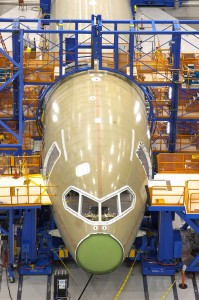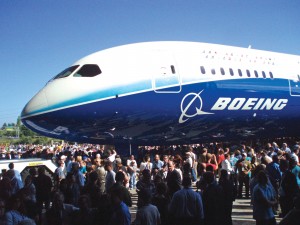
Thousands were on hand to celebrate the rollout of Boeing’s 787 Dreamliner at the company’s assembly plant in Everett, Wash., including employee, airline executives and government officials.
By Terry Stephens
Boeing’s new 787 Dreamliner made its first public appearance on July 8, at its Everett, Wash., assembly plant, launching the company’s new technologically and environmentally advanced airliner. The spectacular event was broadcast live in nine languages via satellite to millions of television viewers.
Master of Ceremonies Tom Brokaw was joined by Jim McNerney, Boeing’s president and CEO; Scott Carson, CEO of Boeing Commercial Airlines; and Mike Bair, vice president and general manager of the 787 program.
All Nippon Airways CEO Mineo Yamamoto, who launched the 787 program with an order for 50 planes, joined the ceremony by satellite. Representatives of several global partners also attended via satellite, including Fuji Heavy Industries and Mitsubishi Heavy Industries, Nagoya, Japan; Alenia Aeronautica, Italy; Global Aeronautica/Vought, Charleston, S.C.; and Spirit Aerosystems, Wichita, Kan.
Thousands of Boeing “787 Team” employees filled the end of the plane’s production bay, while nearly 9,000 additional employees and retirees watched the event on the giant screens at Qwest Field in Seattle. Others watched the event on television from the Museum of Flight at King County International Airport/Boeing Field (BFI) and the Future of Flight Center and Boeing Tour facility at Snohomish County/Paine Field (PAE), half-a-mile from the Everett plant.

This rendering depicts the Dreamliner in flight, anticipated for this fall. Six planes will be used for meeting Federal Aviation Administration certification.
As the hour-long program ended, the giant factory doors rolled open to reveal the first 787 Dreamliner on the concrete ramp outside, bright sunshine gleaming off its Boeing-blue livery. Throngs of airline executives, Boeing officials, employees and news media mobbed the new plane, touching and probing the fuselage, staring at the giant Rolls Royce engines and posing for photos.
In the midst of the crowd of 787 admirers was Steven Udvar-Hazy, founder and CEO of International Lease Finance Co., who earlier in the day was overheard saying, “You’d think that if you buy 74 airplanes, they’d let you take a peek.” His most recent purchase order, in June, was for 52 Dreamliners — two more than launch customer All Nippon Airways. Earlier, ILFC had ordered 22 Dreamliners.
787 Dreamliner sets records
The Dreamliner has a number of firsts to its credit, even before its first test flight, which is set for this fall. With 677 models ordered by 47 airlines by the day of its rollout, it’s the fastest selling new airliner in the company’s history. Also, it’s the first airliner built through an innovative new production network of global partnerships. Boeing workers primarily assemble large sections that arrive aboard Boeing’s new 747 Dreamlifter. Modified by enlarging the top of the fuselage, the plane is able to airlift giant sections of the Dreamliner from production facilities around the world to the Everett plant.
Early in the production cycle, 787s will need eight to 10 days for assembly. Once production lines are running smoothly, Boeing expects to turn out 10 to 13 planes each month. Since the company’s bulging production log already is filled with orders through 2013, Boeing is beginning to explore increasing production to 16 planes a month by 2010. The 787’s flight certification program will use six planes; the first models for commercial service are slated to be delivered by May 2008.
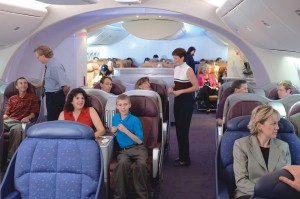
A mock-up of the 787 interior depicts the Dreamliner’s new higher ceilings, wider seats and bigger window design for the twin-aisle airliner.
The phenomenal popularity of the plane has proven Boeing’s choice of marketing strategies to be the right one: offering a new high-technology aircraft with seating for 210 to 330 passengers, significantly improved fuel efficiency, enough range to open up 450 new city-to-city direct routes, and an interior design that provides an improved level of passenger comfort. Boeing officials believe the Dreamliner will make flying fun again for the public.
Boeing’s competitor, Airbus, chose to concentrate on today’s hub-airport network, building its giant new A380 as a double-deck, four-engine airliner with seating for 525 to 853 passengers. The A380 took away Boeing’s 747 title as the world’s largest airliner, but it’s limited to a few select major airports able to accommodate its great size.
Seeing the success of Boeing’s 787, Airbus rushed to compete with its new A350 but found itself a distant second in the race. The Dreamliner projected price will be around $158 million, beating the A350’s expected price tag of $229 million. Also, the A350 is expected to enter service five years after the 787 begins commercial production.
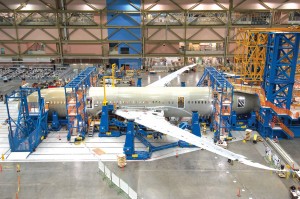
Assembly of the new Boeing 787 needs no rivets for its carbon-composites fuselage and wings or giant overhead cranes to move plane parts along the assembly line.
Airbus has redesigned the A350 five times, which has been a frustration to many of its regular airline customers; potential customers continue to criticize the plane’s lack of new technology and operational cost savings.
First airliner built primarily from composites
The 787 is the first airliner to be built primarily from lightweight, tougher-than-steel carbon-fiber composite materials instead of aluminum. Roughly 51 percent of the plane will be constructed using composites, primarily in the fuselage and wings.
The lighter composites contribute greatly to the 787’s fuel efficiency, as well as lowering maintenance costs and eliminating future problems with metal fatigue and corrosion.
Boeing officials said the company’s been able to make parts out of composites for years, but this is the first time they’ve proven the use of composites on major sections of an aircraft. The first barrel section of the fuselage alone, for instance, would otherwise have been made with 1,500 aluminum sheets fastened together with nearly 50,000 rivets.

Boeing’s assembly plant in Everett, Wash., viewed from the paint hangar and parking ramp south of the facility, produces 747, 767, 777 and 787 airliners.
Airlines also like the 787’s quiet flight. With a 60 percent smaller noise footprint than today’s planes in its class, the Dreamliner’s landing and takeoff decibels are within the boundaries of most large airports. It also has 40 percent more range, 30 percent lower maintenance costs, a 20 percent reduction in fuel use and a 10 percent savings in operating expenses. Additional cargo space adds even more revenue for airlines.
An estimated eight percent of the 787’s new fuel efficiency will come from efficient new engines. Rolls Royce’s Trent 1000 will power most of the first planes, but General Electric’s new GEnx engine is offered as an alternative. Cruising at Mach 0.85, the 787 is comparable to today’s fastest wide-bodied, twin-aisle aircraft.
Engineers designed the plane with passenger comfort in mind, as well. The plane’s wider fuselage provides more spacious ceiling height, bigger overhead baggage lockers, wider seats, improved lighting and more passenger comfort in general, even including larger restrooms. Newly designed windows are 65 percent larger than any competitor’s aircraft. Electrochromic window shades allow passengers to dim brightness but still see the outside views.
The plane’s partial composite construction allows the cabin’s artificial environment to have a sustained atmospheric altitude equal to 6,000 feet — about the same as Sun Valley, Idaho — instead of the generally accepted 8,000 feet level in present airliners. This lower pressurization level, combined with increased humidity to eliminate the dry air usually associated with airliners, will result in a more comfortable flying experience. Considering its powerful impact on Boeing’s sales, the 787 provides the company with an opportunity to win back dominance of the multibillion-dollar jetliner market from Airbus, perhaps as early as 2008. Since it will serve so many point-to-point routes of varying distances and payload much more efficiently than previous jetliners, airlines are ordering large numbers to replace a wide variety of older planes.
The 787-8 flies 7,650 to 8,200 nautical miles with 210 to 250 passengers, compared to the 787-9’s range of 8,000 to 8,500 nautical miles and 250 to 290 passengers. A planned 787-3 will carry 290 to 330 passengers for 2,500 to 3,050 nautical miles.
Emirates Airline, the largest carrier in the Middle East, is already seeking a guarantee from Boeing that it will build a larger version, the 787-10. The airline has plans to buy up to 100 of the stretched 787s, worth around $16 billion, if that model is built. However, airline officials have made it clear it’s also looking at the Airbus A350. So far, there’s been no commitment from Boeing, since only Emirates and Qantas Airways have asked for it. Blair has said that building the 787-10 is a matter of when it will be added, not if it will be done.
The 787: a Snohomish County business builder
In Snohomish County, the 787 has already proven to be a major tourism booster. The Future of Flight Aviation Center and Boeing Tour facility noted an immediate impact on attendance because of the rollout event publicity.
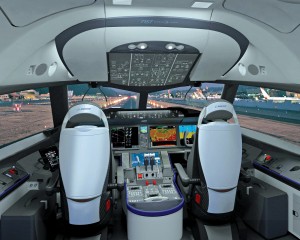
The cockpit of the new 787 has improved visibility and a clean, uncluttered appearance enhanced by glass-cockpit navigation panels.
“Last year we had above 1,000 in attendance only three days; this year we’ve had three weeks of attendance in that range,” said Barry Smith, the center’s executive director. Sandy Ward, marketing director, said July 5 set a record at 1,234 visitors, followed by a new record the next day, at 1,296. June tallied 21,895 visitors, nearly double the 12,033 visits during June 2006.
The 787 is attracting national and global aerospace companies to Snohomish County, including composites pioneers C&D Zodiac, Goodrich Corp., GE Aviation Systems, Messier-Dowty of France and England’s Rolls-Royce aircraft engine division.
So far, three foreign companies have set up offices in the county because of a trade delegation visit to the 2005 Paris Air Show, led by Washington Gov. Christine Gregoire and Snohomish County Executive Aaron Reardon. When Reardon returned to the 2007 air show, he found that more people understood where Snohomish County was on the globe than before, thanks to increasing news reports of Boeing’s 787 production.
John Hopton, Rolls Royce vice president of operations, said the company set up a local office to build a relationship with The Boeing Co. The British company is providing its new Trent 1000 engine for the Dreamliner.
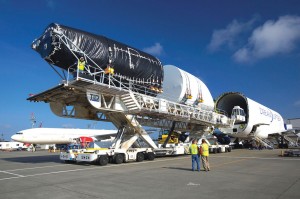
Boeing is building four enlarged 747-400s to deliver huge sections of the 787 to its plant from around the world.
Goodrich Corp.’s newly opened facility south of the Boeing plant builds nacelles for both the Rolls Royce and GE engines. General Manager Dave Kaupes said the company’s presence in the county saves shipping costs and improves manufacturing efficiency for its Aerostructures Integration Services division.
Jim Shaw, vice president of GE’s Boeing Civil Aircraft program, said the company’s presence near the 787 plant allows him to interact with other aerospace firms. That’s an important factor because the 787 involves new technology and a new system of working with suppliers.
Cynthia Raynor, vice president and general manager of C&D Zodiac, said she was pleased to find a work force of highly trained people in the county. The firm’s divisions include the former Northwest Composites in Marysville.
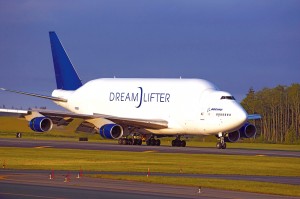
Boeing’s 747 Dreamlifter lands at Paine Field to deliver large 787 sections from production partners in Japan, Italy and the United States.
John Herring, vice president of the Boeing 787 program for Messier-Dowty, said the company established a presence in the area several years ago to show it was interested in Boeing’s 787 production. Today, the global landing-gear manufacturer has a new 25,000-square-foot final assembly plant near the Boeing plant to assemble the plane’s main landing gear using segments from its facilities in France, England and China.
While the predicted presence of Boeing suppliers near the 787 plant hasn’t happened as quickly as county officials had hoped, several companies already were in place by the time of the rollout. Deborah Knutson, executive director of the Snohomish County Economic Development Council, said now that Boeing is preparing to ramp up for long-term production of the new Dreamliner, more worldwide businesses are expected to establish offices and production facilities in the area.
More information on the 787 is available at [http://www.boeing.com] or [http://www.newairplane.com].












